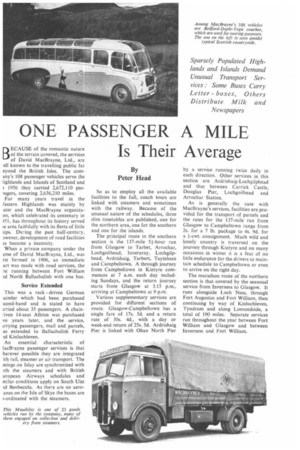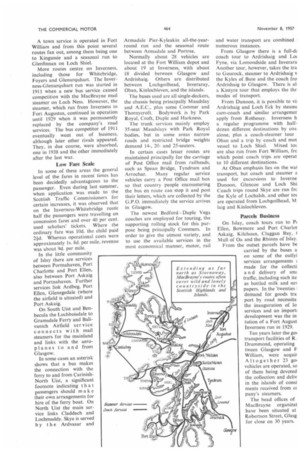ONE PASSENGER A MILE Is Their Average
Page 131

Page 132

If you've noticed an error in this article please click here to report it so we can fix it.
By Peter Head
BECAUSE of the romantic nature of the terrain covered, the services of David MacBrayne, Ltd., are
• eIl known to the travelling public far eyond the British Isles. The cornany's 108 passenger vehicles serve the tighlands and Islands of Scotland and 1 1956 they carried 2,672,110 pasTigers, covering 2,636,210 miles.
For many years travel in the Testern Highlands was mainly by ater and the MacBrayne organizaon, which celebrated its centenary in )51, has throughout its history served ie area faithfully with its fleets of little tips. During the past half-century, 3wever, development of road facilities is become a necessity.
When a private company under the ime of David MacBrayne, Ltd., was Est formed in 1906, an immediate art was made with road services, the -St running between Fort William id North Ballachulish with one bus.
Service Extended
This was a rack driven German
■ aimler which had been purchased :cond-hand and is stated to have irried about 35 passengers. A chain-iven 14-seat Albion was purchased vo years later, and the service, trrying passengers, mail and parcels, as extended to Ballachulish Ferry id Kinlochleven.
An essential characteristic of lacBrayne passenger services is that herever possible they are integrated ith rail, steamer or air transport. The mings on Islay are synchronized with )th the steamers and with British uropean Airways schedules and milar conditions apply on South Uist Id Benbecula. As there are no aeroanes on the Isle of Skye the buses are i-ordinated with the steamers. So as to employ all the available facilities to the full, coach tours are linked with steamers and sometimes with the railway. Because of the unusual nature of the schedules, three slim timetables are published, one for the northern area, one for the southern and one for the islands.
The principal route in the southern section is the 137-mile 5i-hour run from Glasgow to Tarbet, Arrochar, Lochgoilhead, Inveraray, Lochgilphead, Ardrishaig, Tarbert, Tayinloan and Campbeltown. A through journey from Campbeltown in Kintyre commences at 7 a.m. each day including Sundays, and the return journey starts from Glasgow at 3.15 p.m., arriving at Campbeltown at 9 p.m.
Various supplementary services are provided for different sections of route. Glasgow-Campbeltown has a single fare of 17s. 5d. and a return rate of 30s. 4d., with a day or week-end return of 25s. 5d. Ardrishaig Pier is linked with Oban North Pier
by a service running twice daily in each direction. Other services in this section are Ardrishaig-Lochgilphead and that between Carrick Castle, Douglas Pier, Lochgoilhead and Arrochar Station.
As is generally the case with MacBrayne's services, facilities are provided for the transport of parcels and the rates for the 137-mile run from Glasgow to Campbeltown range from 2s. for a 7 lb. package to 4s. 9d. for a f-cwt. consignment. Much wild and lonely country is traversed on the journey through Kintyre and on many occasions in winter it is a feat of no little endurance for the drivers to maintain schedule to Campbeltown or even to arrive on the right day.
The marathon route of the northern section is that covered by the seasonal service from Inverness to Glasgow. It runs alongside Loch Ness, through Fort Augustus and Fort William, then continuing by way of Kinlochleven, Tyndrum and along Lomondside, a total of 190 miles. Separate services run throughout the year between Fort William and Glasgow and between Inverness and Fort William. A town service is operated in Fort William and from this point several routes fan out, among them being one to Kingussie and a seasonal run to Glenfinnan on Loch Shiel.
More routes centre on Inverness, including those for Whitcbridge, Foyers and Glenurquhart. The Inverness-Glenurquhart run was started in 1911 when a new bus service caused competition with the MacBrayne mail steamer on Loch Ness. However, the steamer, which ran from Inverness to Fort Augustus, continued in operation until 1929 when it was permanently replaced by the company's road services. The bus competitor of 1911 eventually went out of business, although later other rivals appeared. They, in due course, were absorbed, one in 1938 and the other immediately after the last war.
Low Fare Scale
In some of these areas the general level of the fares in recent times has been decidedly advantageous to the passenger. Even during last summer, when application was made to the Scottish Traffic Commissioners for certain increases, it was observed that on the Inverness-Whitebridge route half the passengers were travelling on concession fares and over 40 per cent. used scholars' tickets. Where the ordinary fare was 10d. the child paid 21d. Whereas operational costs were approximately Is. 8d. per mile, revenue was about 9d. per mile.
In the little community of Islay there are services between Portnahaven, Port Charlotte and Port Ellen, also between Port Askaig and Portnahaven. Further services link Ardbeg, Port Ellen, Glenegedale (where the airfield is situated) and Port Askaig.
On South Uist and Benbecula the Lochboisdale to Gramsdale Ferry and Balivanich Airfield service connects with mail steamers for the mainland and links with the aeroplanes to and from Glasgow.
In some cases an asterisk shows that a bus makes the connection with the ferry to and from CarinishNorth Uist, a significant footnote indicating that passengers should make their own arrangements for hire of the ferry boat. On North Uist the main service links Claddach and Lochmaddy. Skye is served by the Ardvasar and Armadale Pier-Kyleakin all-the-yearround run and the seasonal route between Armadale and Portree.
Normally about 28 vehicles are located at the Fort William depot and about 19 at Inverness, with about 18 divided between Glasgow and Ardrishaig. Others are distributed between Lochgoilhead, Inveraray, Oban, Kinlochleven, and the islands.
The buses used are all single-deckers, the chassis being principally Maudslay and A.E.C., plus some Commer and Thornycroft. Bodywork is by Park Royal, Croft, Duple and Harkness.
The trunk services mainly employ 35-seat Maudslays with Park Royal bodies, but in some areas narrow roads and restricted bridge weights demand 14-, 20and 25-seaters.
In certain cases lesser routes are maintained principally for the carriage of Post Office mail from railheads, such as Spean Bridge, Tyndrum and Arrochar. Many regular service vehicles carry a Post Office mail box so that country people encountering the bus en route can stop it and post their letters, which are collected by the G.P.O. immediately the service arrives in Glasgow.
The newest Bedford Duple Vega coaches are employed for touring, the supporting rolling stock for this purpose being principally Commers. In order to give the utmost variety, and to use the available services in the most economical manner, motor, rail and water transport are combined numerous instances.
From Glasgow there is a full-dc coach tour to Ardrishaig and Loc Fyne, via Lomondside and Inverara Another tour, however, takes the tra to Gourock, steamer to Ardrishaig v the Kyles of Bute and the coach fro Ardrishaig to Glasgow. There is at a Kintyre tour that employs the thr modes of transport.
From Dunoon, it is possible to vi Ardrishaig and Loch Eck by steamc cum-coach and similar arrangemer apply from Rothesay. Inverness h a regular programme with halfdozen different destinations by coa, alone, plus a coach-steamer tour Oban and a trip by coach and mot vessel to Loch Shiel. Mixed tot are also run from Fort William, fro which point coach trips are operat to 10 different destinations.
At Oban emphasis lies on the wai transport, but coach and steamer a used for excursions to lnverne Dunoon, Glencoe and Loch Shi Coach trips round Skye are run frc the Kyle of Lochalsh, and other tot are operated from Lochgoilhead, M; laig and Kinlochleven.
Parcels Business
On Islay, coach tours run to P4 Ellen, Bowmorc and Port Chariot Askaig, Kilchoan, Claggan Bay, t Mull of Oa and the Rhinns of Islay.
From the outset parcels have be carried by the buses a
on some of the outlyi services arrangements ; made for the collecti a n d delivery of srm traffic, including such ite as bottled milk and nel papers. In the 'twenties 1 demand for goods tra. port by road necessitai the inauguration of lo services and an import; development was the in tution of a Fort August Inverness run in 1929.
Ten years later the goi transport facilities of R. Drummond, operating tween Glasgow and F William, were acquir Altogether 23 got vehicles are operated, so of them being devoted the collection and deliv in the islands of consi ments received from cc pany's steamers.
The head offices of M acB rayne organ izat have been situated at Robertson Street, Glasg for close on 30 years.




























































































































































































































































